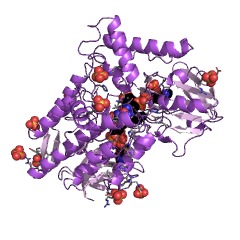| Synonyms |
17alpha-Hydroxyprogesterone, NADPH2:oxygen oxidoreductase (20-hydroxylating, side-chain cleaving), Androgen hydroxylase, Androstenedione, NADPH2:oxygen oxidoreductase (17-hydroxylating, lactonizing), Baeyer-Villiger monooxygenase, BVMO, CYP106A2, Hydroxylase, steroid, NADPH-dependent steroid Baeyer-Villiger monooxygenase, Oxygenase, steroid mono-, Progesterone, NADPH2:oxygen oxidoreductase (20-hydroxylating, ester-producing), Steroid hormone hydroxylase, Steroid hydroxylase, steroid hydroxylating cytochrome, Steroid monooxygenase, Steroid-ketone monooxygenase, STMO |
| Comments |
A single FAD-containing enzyme catalyses three types of monooxygenase (Baeyer-Villiger oxidation) reaction. The oxidative esterification of a number of derivatives of progesterone to produce the corresponding 17¦Á-hydroxysteroid 17-acetate ester, such as testosterone acetate, is shown in Reaction (2). The oxidative lactonization of a number of derivatives of androstenedione to produce the 13,17-secoandrosteno-17,13¦Á-lactone, such as testololactone, is shown in Reaction (3). The oxidative cleavage of the 17¦Â-side-chain of 17¦Á-hydroxyprogesterone to produce androstenedione and acetate is shown in Reaction (4). Reaction (2) is also catalysed by EC 1.14.99.4 (progesterone monooxygenase), and Reactions (3) and (4) correspond to that catalysed by EC 1.14.99.12 (androst-4-ene-3,17-dione monooxygenase). The possibility that a single enzyme is responsible for the reactions ascribed to EC 1.14.99.4 and EC 1.14.99.12 in other tissues cannot be excluded. |


